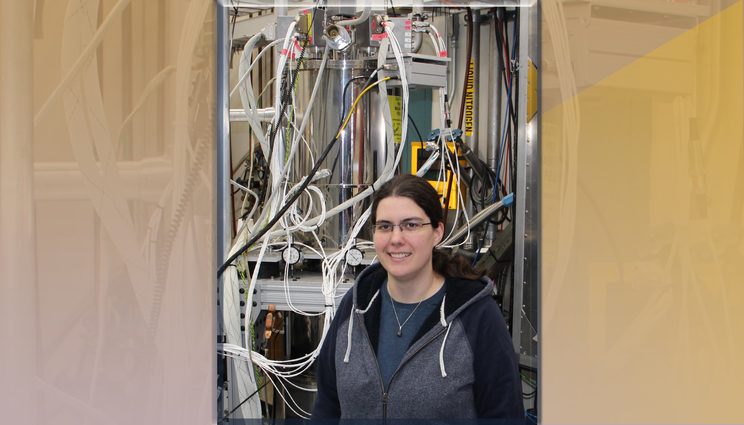Lab physicist awarded 2020 dissertation prize
 (Download Image)
(Download Image)
Lawrence Livermore physicist Natalie Hell has been awarded the 2020 Dissertation Prize from the Laboratory Astrophysics Division of the American Astronomical Society.
Lawrence Livermore National Laboratory (LLNL) physicist Natalie Hell has been awarded the 2020 Dissertation Prize from the Laboratory Astrophysics Division (LAD) of the American Astronomical Society (AAS).
Hell received the prize for her outstanding experimental doctoral dissertation in laboratory astrophysics. Her thesis, “Benchmarking Transition Energies and Emission Strengths for X-ray Astrophysics With Measurements at the Livermore EBITs,” was cited for groundbreaking laboratory measurements necessary for accurate, reliable interpretation of high-resolution X-ray spectra from astronomical sources.
Hell started at LLNL as an undergraduate summer intern, working with Greg Brown at the Electron Beam Ion Trap (EBIT) facility. The internship was through the RISE in North America exchange program and sponsored by the highly competitive German Academic Exchange Service. She later returned to the Lab to carry out measurements in support of her master’s thesis, and then joined LLNL full time to carry out her Ph.D. work, also at the EBIT facility.
“The importance of the work of the LLNL EBIT group in providing accurate atomic physics data has been recognized by the astrophysics and plasma physics communities in the past,” Hell said. “I feel honored by this award validating my efforts to carry on the high standards of our EBIT work.”
The measurements featured in Hell’s thesis continue a long history of studies of the physics of highly charged ions and laboratory astrophysics at LLNL’s EBIT facility. These data are necessary for interpreting spectra from celestial sources, and for benchmarking and improving plasma models employed by the high energy astrophysics community, as well as the fusion energy and high energy density physics communities.
Hell’s research combines astrophysical observations, laboratory experiments and theoretical calculations to reveal physical processes occurring throughout the cosmos. For her thesis she measured wavelengths and line strengths with Livermore’s EBIT, then used them to interpret spectra from binary systems consisting of a black hole and a massive star, revealing how interstellar gas clouds are influenced by radiation coming from around the black hole.
Her work has been vital in understanding high-resolution X-ray spectra taken with the Chandra and XMM-Newton X-ray observatories. The upcoming new era of space-borne, high-resolution X-ray spectroscopy measurements, using high-resolution quantum calorimeters brought on by the X-ray Imaging and Spectroscopy Mission (XRISM) and Advanced Telescope for High-Energy Astrophysics (Athena) X-ray observatory, sets even more stringent requirements on the accuracy of the data related to the physics of highly charged ions. XRISM will launch in 2022 and is led by the Japan Aerospace and Exploration Agency and NASA. Athena will launch in the late 2020s and is led by the European Space Agency.
“I am excited to be able to continue this work at LLNL with the EBIT group and as a member of the XRISM and Athena teams ushering in this next big step of X-ray astrophysics,” Hell said.
Hell earned her Ph.D. at Friedrich-Alexander University Erlangen-Nürnberg, Germany, where she worked at Karl Remeis Observatory in Bamberg as well as the Erlangen Centre for Astroparticle Physics. LLNL’s Brown was a co-adviser. Hell is currently a staff physicist in the Astrophysics and Advanced Diagnostics group in the Applied Physics section of the Physical and Life Sciences Directorate.
The prize includes a cash award, a framed certificate and an invited lecture by Hell at a meeting of the AAS Laboratory Astrophysics Division.
Contact
 Anne M. Stark
Anne M. Stark
[email protected]
(925) 422-9799
Related Links
LLNL Electron Beam Ion Trap (EBIT)American Astronomical Society
Benchmarking Transition Energies and Emission Strengths for X-ray Astrophysics with Measurements at the Livermore EBIT
Tags
PhysicsSpace Science Institute
Physical and Life Sciences
Featured Articles







